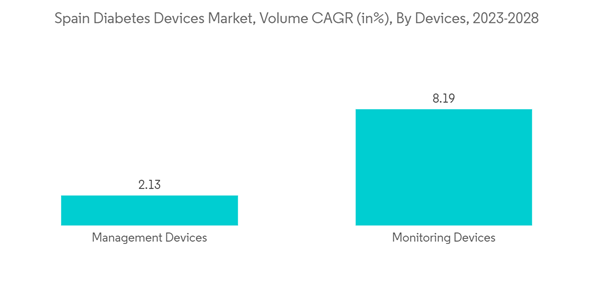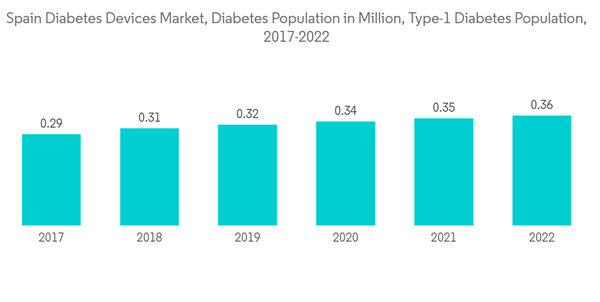The Spain Diabetes Devices Market size is estimated at USD 0.71 billion in 2024, and is expected to reach USD 1.02 billion by 2029, growing at a CAGR of 7.41% during the forecast period (2024-2029).
In Sapin According to WHO, as of 25 June 2022, a total of 102,258,825 vaccine doses have been administered. Regardless of previous diabetes history, admission hyperglycemia is a significant predictor of all-cause death in non-critically hospitalized COVID-19 patients. Spain was among the nations most severely impacted by the COVID-19 pandemic in 2020. A total countrywide lockdown was implemented from 14 March 2020 through 21 June 2020 to limit the epidemic due to an increase in instances. The government reinstated a state of emergency on October 25 due to a return of cases after a nearly 4-month period during which certain restrictive measures had been lifted. This included partial lockdown measures with movement limitations that would extend until May 9 of 2021.
Critical elements of the therapy of type 1 diabetes include medical devices (T1D). Devices include insulin pumps, continuous glucose monitors (CGMs), and blood glucose meters. These gadgets are linked to better glucose management and decreased hypoglycemia.
In Spain, the COVID-19 epidemic compelled the government to enact unusual laws and regulations in order to stop the virus' spread. Lockdown proved to be a successful strategy for lowering the risk of infection. Therefore, owing to the aforesaid factors, the growth of the studied market is anticipated in Spain.
The number of people with diabetes in Spain has sharply increased during the last two years. According to Dr. Antonio Pérez Pérez, President of the Spanish Diabetes Association (SED) and Director of the Department of Endocrinology and Nutrition at the Hospital de la Santa Creu I Sant Pau in Barcelona, this is a concerning trend that affects millions of people's lives nationwide.
Therefore, owing to the aforesaid factors, the growth of the studied market is anticipated in Spain.
This product will be delivered within 2 business days.
In Sapin According to WHO, as of 25 June 2022, a total of 102,258,825 vaccine doses have been administered. Regardless of previous diabetes history, admission hyperglycemia is a significant predictor of all-cause death in non-critically hospitalized COVID-19 patients. Spain was among the nations most severely impacted by the COVID-19 pandemic in 2020. A total countrywide lockdown was implemented from 14 March 2020 through 21 June 2020 to limit the epidemic due to an increase in instances. The government reinstated a state of emergency on October 25 due to a return of cases after a nearly 4-month period during which certain restrictive measures had been lifted. This included partial lockdown measures with movement limitations that would extend until May 9 of 2021.
Critical elements of the therapy of type 1 diabetes include medical devices (T1D). Devices include insulin pumps, continuous glucose monitors (CGMs), and blood glucose meters. These gadgets are linked to better glucose management and decreased hypoglycemia.
Spain Diabetes Devices Market Trends
Monitoring Devices Hold Highest Market Share in Spain Diabetes Care Devices Market in the current year
Patients with type-1 diabetes (T1D) must maintain healthy lifestyle conditions, which depend on a person's personality traits, social interactions, socioeconomic circumstances, and environmental living factors. The use of continuous glucose monitoring (CGM) with multiple daily injections (MDI) has shown a reduction in non-severe and severe hypoglycemia in people with type-1 diabetes prone to this adverse event. Patients with T1D who were at high risk of hypoglycemia could control their blood sugar levels even amid the harsh living circumstances imposed by the COVID-19 pandemic crisis' severe lockdown thanks to the use of standalone continuous glucose monitoring. A little improvement in glucometric markers, particularly those connected to glucose exposure, was linked to the lockdown time. The Spanish hospitals ordered CGM devices to limit staff contact with a large portion of diabetic patients infected with COVID-19. The choices made by national bodies, like the Ministry of Health in Italy and the Agencia Española de Medicamentos y Productos Sanitarios in Spain, had a very narrow scope. These organizations typically have the capacity to accept or reject a product from the market, but they infrequently use this authority for novel gadgets. Spain now has the second-highest prevalence of diabetes in Europe at 14.8%, or one in every seven people. Also, Spain now ranks among the top 10 nations in terms of the amount spent on diabetes-related healthcare, with a total of 15.5 billion USD.In Spain, the COVID-19 epidemic compelled the government to enact unusual laws and regulations in order to stop the virus' spread. Lockdown proved to be a successful strategy for lowering the risk of infection. Therefore, owing to the aforesaid factors, the growth of the studied market is anticipated in Spain.
Increasing Type -1 Diabetes Population in Spain Boosting the Spain Diabetes Devices Market.
In Spain, the type-1 diabetes population increased, registering a CAGR greater than 3% over the forecast period. More than 0.35 million people were expected to be living with type-1 diabetes in 2021. Up to 13.8% of adults in Spain are believed to have diabetes, with around 6% having diabetes that has not yet been diagnosed. Similar prevalence numbers have been noted in the five million-person Valencian Community, an area of Spain. In this area, primary care doctors monitor most diabetic patients and collaborate closely with endocrinologists to handle more complicated cases. Numerous articles noted that people with diabetes were more likely to experience more severe COVID-19 instances, have worse outcomes, and have higher fatality rates. The SED anticipates the fatality rate to multiply, as the mortality risk is estimated to be around 7.3% for the Spanish population suffering from diabetes, unlike the 0.9%-3% mortality risk associated with the non-diabetic population. In Spain, 30.3% of those with diabetes have never received a diagnosis. Diabetes can result in serious and sometimes fatal consequences like heart attack, stroke, kidney failure, blindness, and lower limb amputation when it is not recognized or treated properly. They have the effect of lowering quality of life and raising healthcare expenses.The number of people with diabetes in Spain has sharply increased during the last two years. According to Dr. Antonio Pérez Pérez, President of the Spanish Diabetes Association (SED) and Director of the Department of Endocrinology and Nutrition at the Hospital de la Santa Creu I Sant Pau in Barcelona, this is a concerning trend that affects millions of people's lives nationwide.
Therefore, owing to the aforesaid factors, the growth of the studied market is anticipated in Spain.
Spain Diabetes Devices Industry Overview
The new technologies in diabetes devices, like continuous glucose monitoring, have increased the market for monitoring devices. The mergers and acquisitions between the players, like the acquisition of TypeZero Technologies by Dexcom, are paving the way for automated insulin delivery. The acquisition has sent Dexcom ahead on its way in the race to create an artificial pancreas system, rather than merely offering a boost to the continuous glucose monitoring devices market.Additional Benefits:
- The market estimate (ME) sheet in Excel format
- 3 months of analyst support
This product will be delivered within 2 business days.
Table of Contents
1 INTRODUCTION
4 MARKET DYNAMICS
5 MARKET SEGMENTATION
6 MARKET INDICATORS
7 COMPETITIVE LANDSCAPE
Companies Mentioned (Partial List)
A selection of companies mentioned in this report includes, but is not limited to:
- Becton and Dickenson
- Medtronic
- Insulet
- Tandem
- Ypsomed
- Novo Nordisk
- Sanofi
- Eli Lilly
- Abbottt
- Roche
- Lifescan (Johnson &Johnson)
- Dexcom
Methodology

LOADING...










